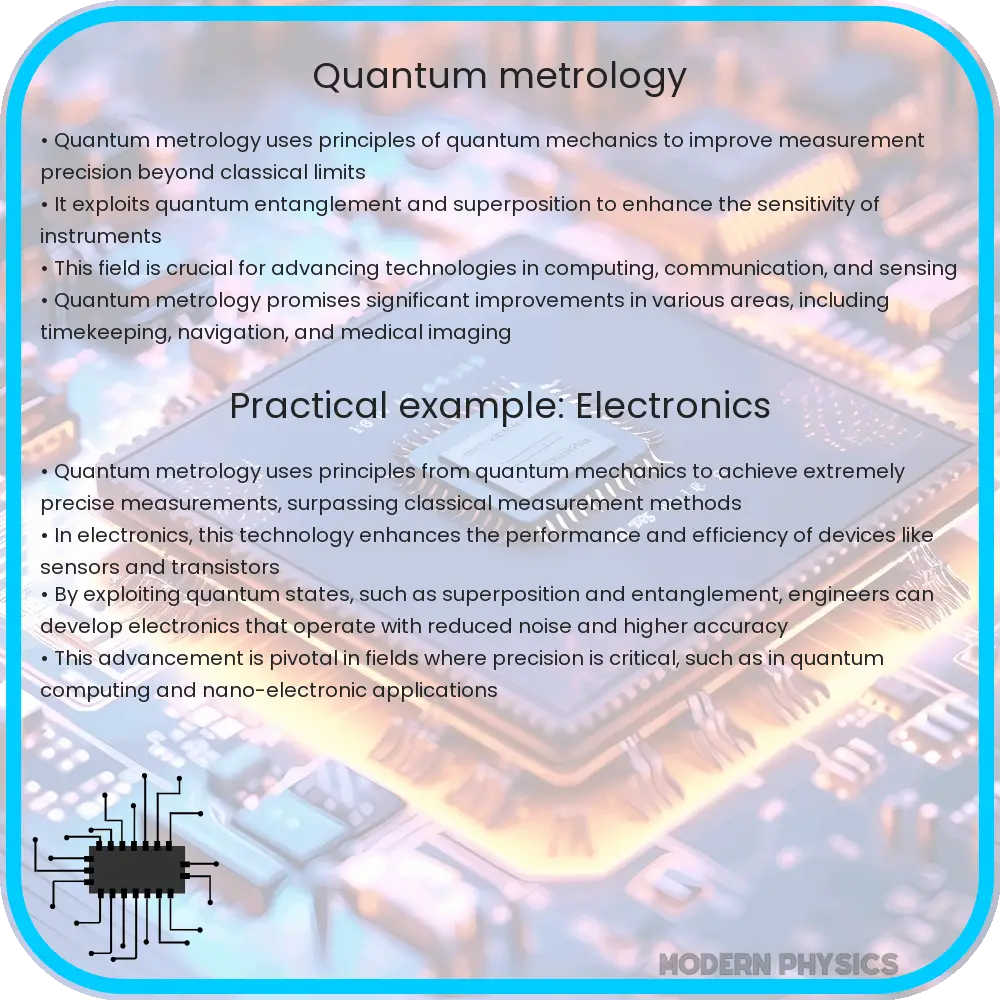Explore the world of Quantum Metrology and its revolutionary impact on precision and accuracy in science and technology, from healthcare to GPS.

Understanding Quantum Metrology
Quantum Metrology, an emerging field at the intersection of quantum physics and measurement science, offers unprecedented precision and accuracy in measurements. This advanced branch of metrology leverages quantum mechanics principles to enhance the capabilities of standard measurement techniques, promising significant breakthroughs in various scientific and technological domains.
The Principle of Quantum Metrology
At its core, quantum metrology utilizes quantum states and quantum entanglement to improve measurement sensitivity and accuracy. Quantum states, such as photons or atoms, are manipulated to carry information about the physical quantity being measured. Quantum entanglement, a phenomenon where quantum states become interconnected and the state of one cannot be described without the other, further enhances measurement precision. This is because entangled states can reduce statistical errors more effectively than classical methods.
Applications of Quantum Metrology
The implications of quantum metrology are vast and diverse. One of the key areas of application is in the field of gravitational wave detection. Advanced LIGO (Laser Interferometer Gravitational-Wave Observatory) and other similar experiments benefit significantly from quantum metrology techniques. By employing squeezed light – a quantum state of light with reduced quantum noise – these observatories have improved their sensitivity to detect these elusive ripples in spacetime.
- Healthcare: In the medical field, quantum metrology can enhance the precision of imaging techniques like MRI, leading to better diagnosis and treatment.
- Navigation: Quantum sensors can revolutionize navigation systems by providing ultra-precise measurements of gravitational fields, which could be crucial in both civilian and military applications.
- Timekeeping: Quantum metrology has already impacted timekeeping, with atomic clocks reaching new heights in accuracy, thus improving global navigation satellite systems like GPS.
Challenges in Quantum Metrology
Despite its potential, quantum metrology faces several challenges. The most prominent is the decoherence of quantum states. In quantum systems, interaction with the environment can lead to the loss of quantum properties, which is detrimental to the precision of quantum measurements. Therefore, maintaining the integrity of quantum states in practical settings remains a significant hurdle. Additionally, the complexity and cost of quantum measurement devices are currently higher than traditional methods, posing a challenge for widespread adoption.
However, with continuous research and development, quantum metrology is poised to overcome these challenges, paving the way for a new era of measurement precision and accuracy.
Advancements in Quantum Metrology
The field of quantum metrology is rapidly evolving, with researchers worldwide making significant strides. Recent advancements include the development of more robust quantum sensors that are less susceptible to environmental noise, and the integration of quantum metrology techniques in commercial products. For instance, highly sensitive quantum magnetometers are being used in geological surveys and brain imaging.
The Future of Quantum Metrology
Looking forward, the potential of quantum metrology extends far beyond current applications. One area of particular interest is in the realm of quantum computing. Quantum metrology could play a crucial role in enhancing the performance of quantum computers by improving the precision of quantum bit (qubit) measurements. This precision is vital for the effective operation of quantum computers.
Another exciting prospect is in the field of environmental monitoring. Quantum sensors could enable the detection of minute changes in environmental parameters, aiding in the early detection of natural disasters, such as earthquakes or volcanic eruptions. The ability to measure tiny changes in gravitational fields can provide critical data for these applications.
Investment and Collaboration in Quantum Metrology
Recognizing the potential of quantum metrology, governments and private entities are increasing their investment in this field. Collaborative efforts between academic institutions, industry, and government agencies are essential for driving innovation and application. Such collaborations not only fund research but also facilitate the exchange of knowledge and the development of standardized methods in quantum measurement.
Furthermore, educational initiatives are crucial for cultivating the next generation of scientists and engineers in this field. By integrating quantum metrology into academic curricula, we can ensure a steady influx of talent to propel this field forward.
Conclusion
Quantum metrology, with its promise of unparalleled precision and accuracy, is set to revolutionize the way we measure and understand the world. From enhancing healthcare diagnostics to refining timekeeping, the applications of quantum metrology are as vast as they are impactful. As we continue to overcome its challenges and harness its potential, the future of measurement science looks brighter than ever. In this era of technological marvels, quantum metrology stands out as a beacon of innovation, precision, and endless possibilities.
